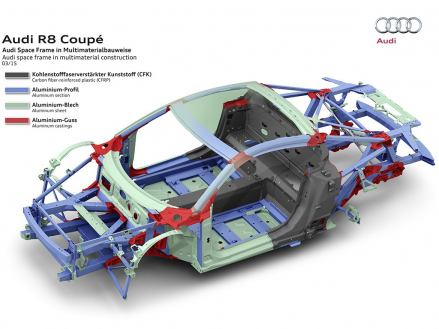New Audi Space Frame with high proportions of aluminum and CFRP
The R8 V10 plus* has a dry weight of 1,454 kilograms (3,205.5 lb). The key factor behind the consistent lightweight design is the body shell with multimaterial Audi Space Frame (ASF): It weighs only 200 kilograms (440.9 lb). The resulting unladen weight of 1,555 kilograms(3,428.2 lb) leads to a superior power-to-weight ratio of 3.46 kg/kW (2.55 kg/hp).
The ASF body shell features a completely new multimaterial lightweight construction concept. Components made from carbon fiber reinforced plastics (CFRP) form the B pillars, the central tunnel and the rear wall. The front section of the vehicle, the roof arch and the rear section form a framework made from cast aluminum nodes and aluminum profiles which, in some cases, employ new alloys. As always with the ASF, each component is precisely designed for its location and purpose. Accordingly, the engineers have now integrated some components into the body shell due to their function. Leaving aside its components, the body shell is now around 15 percent lighter than its predecessor. At the same time, torsional rigidity is roughly 40 percent better. Particularly with regard to rigidity, the body of the new Audi R8 is a benchmark. The resulting lightweight construction is unparalleled among the competition.
The multimaterial Audi Space Frame in the new Audi R8 is extremely light and rigid, whilst also being acoustically comfortable and offering a high level of safety. The outer skin is made entirely of aluminum, but as an optional extra (or as standard for the V10 plus), Audi also offers attachment parts made from clear-coated carbon fiber, for example the front splitter, the diffuser or the side blades. A long, rising diffuser in the underbody produces downforce on the rear axle at higher speeds.
*Combined fuel consumption in l/100 km: 12.4 – 11.8 (19.0 – 19.9 US mpg)**;
Combined CO2 emissions in g/km: 289 – 275 (465.1 – 442.6 g/mi)**
**Figures depend on the tires/wheels used.
Status: 3/2015
